Part 4: Dances of the Balkans
13 Dances of Macedonia and Bulgaria
1. Introduction
In this chapter, we’re going to look at the music and dance from two cultural regions in the eastern Balkans, Macedonia and Bulgaria. Although they are distinct cultures with different language, dress, music and dance. There are many similarities between these neighbors, so we will treat them together.
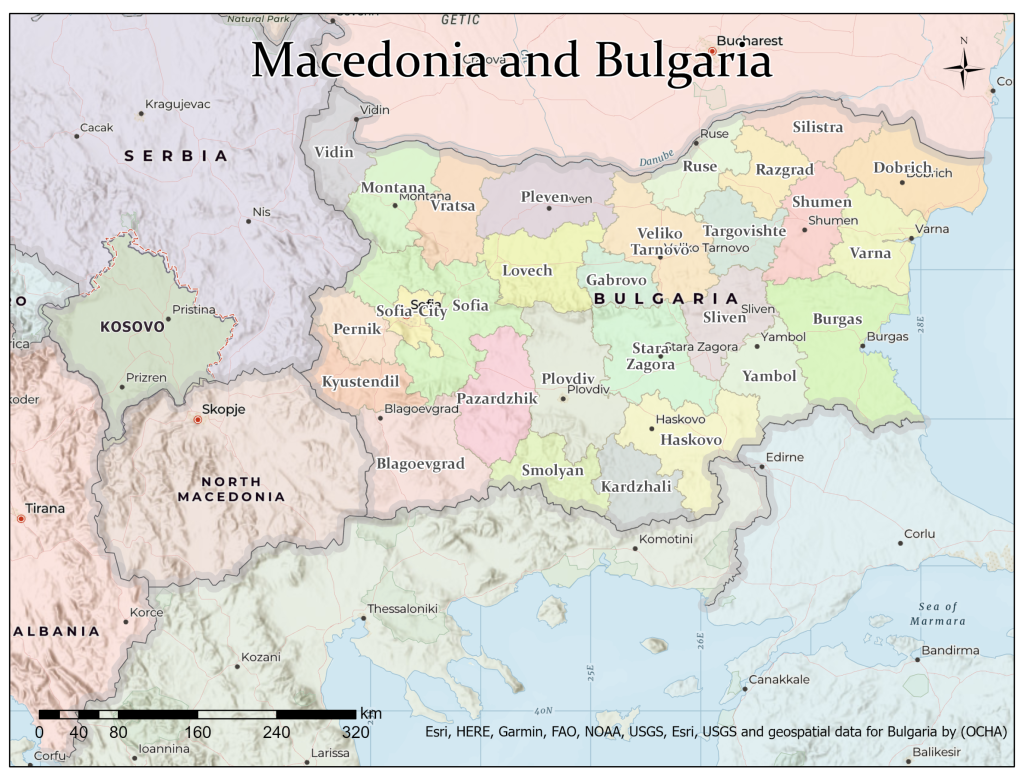
2. Macedonia (Македонија/Μακεδονία)
2.1. The History of Macedonia
In the history of the western world, Macedonia holds an outsized role for such a small country, especially in ancient times.[1] The ancient Hellenic Macedonian Empire of Alexander the Great stretched from North Africa all the way to India. The ancient Macedonians were a major cultural force in the Region and much of what we think of as “Ancient Greek” culture came from Macedonia.
After Alexander the Great, many empires and societies have ruled the traditional region of Macedonia, each leaving their own stamp. It was at various times part of the Greek Republic, the Roman Empire, the Byzantine Empire, and the Ottoman Empire. In modern times various parts of Macedonia have been part of Greece, Bulgaria, Yugoslavia and have been independent. There are also several different ethnicities and linguistic groups that have lived in the area. Look at the following map of historical Macedonia.
.
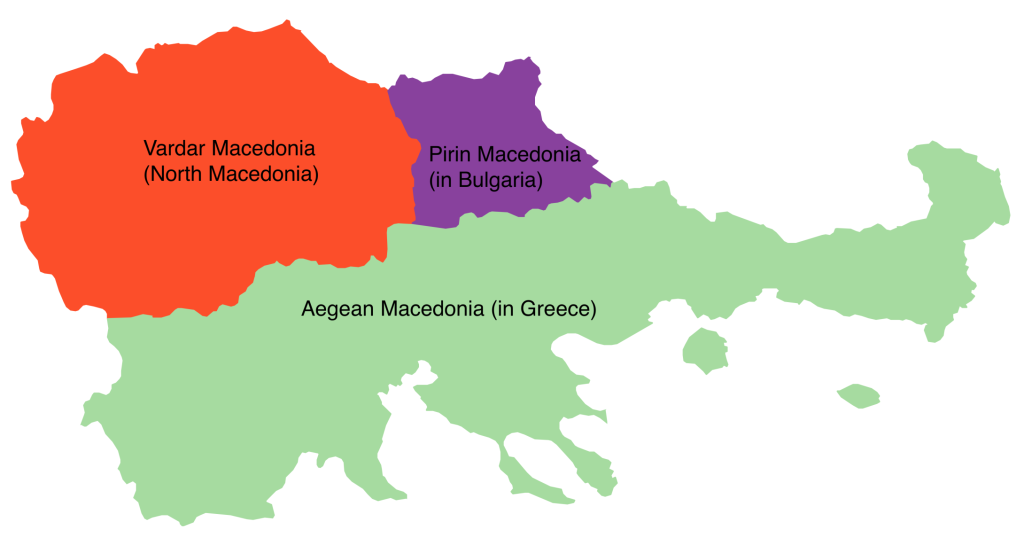
We can roughly divide this area into three modern regions. In the south, we have the region that is currently part of modern Greece, we can call this area Aegean Macedonia, because it borders the Aegean Sea. Today this region is politically, linguistically, and culturally integrated into Greece. The majority/official language is Greek. There are, however, important minority groups where they speak Slavic Macedonian, another language related to Romanian called Vlach, and Albanian. Historically there were also large Turkish speaking populations here, however they were forcibly removed to Turkey after the collapse of the Ottoman Empire.
To the Northeast there is a region we can call Pirin Macedonia after the Pirin Mountains in the region. Pirin is now part of modern Bulgaria. The language spoken in this area is Slavic Macedonian, but with significant influence from Bulgarian, which is the official language of Bulgaria.
Finally, to the northeast we find Vardar Macedonia, named after the Vardar River. The primary language in this region is Slavic Macedonian, although there are significant populations of Albanian, Vlach and Serbian speakers. This region is the source of much controversy in recent times. After World War II, Vardar Macedonia was one of the component countries of Yugoslavia (along with Slovenia, Croatia, Bosnia-Herzegovina, Serbia, and Montenegro) and so developed a unique political identity. After the collapse of Yugoslavia, the region emerged as an independent republic, officially called The Republic of Macedonia. The choice of this name was the source of great strife (Bates 1994). Greece vociferously objected to this name, because of the large part of its territory that is also part of historical Macedonia. The country was variously known by outside bodies as “The former Yugoslav Republic of Macedonia” or FYROM and somewhat pejoratively “The Skopje Republic” (after its capital city). In 2019 the Greek and Macedonian governments reached a compromise that the country would be officially known as the “Republic of North Macedonia”. This deal is not universally loved, and was the cause of riots in Greece[2], but it has paved the way for North Macedonia to enter the European Union, which was previously blocked by Greece.
Despite the political and linguistic divisions in historical Macedonia, the three regions have a great deal in common in terms of musical style and dance traditions. From this point forward, in this reading, when I refer to Macedonia, I’m talking about all three regions (Vardar/North Macedonia, Pirin and Aegean Macedonian).
2.2. Macedonian Folk Costumes
Although located fairly far south in Europe, Macedonia is largely a mountainous region so it’s quite cold in places. Macedonian costumes reflect this environment. Costumes often consist of thick woolen and felted garments. They are often highly embroidered. As in other places where there was a strong Ottoman presence, the costumes show a great deal of Turkish influence. The men wear baggy trousers and short vests and both genders wear large wide belts. Colorful complex-patterned socks are also common. To complete the costume, they wear various styles of Turkish-influenced leather opanci on their feet and women wear heavy silver jewelry and belts.
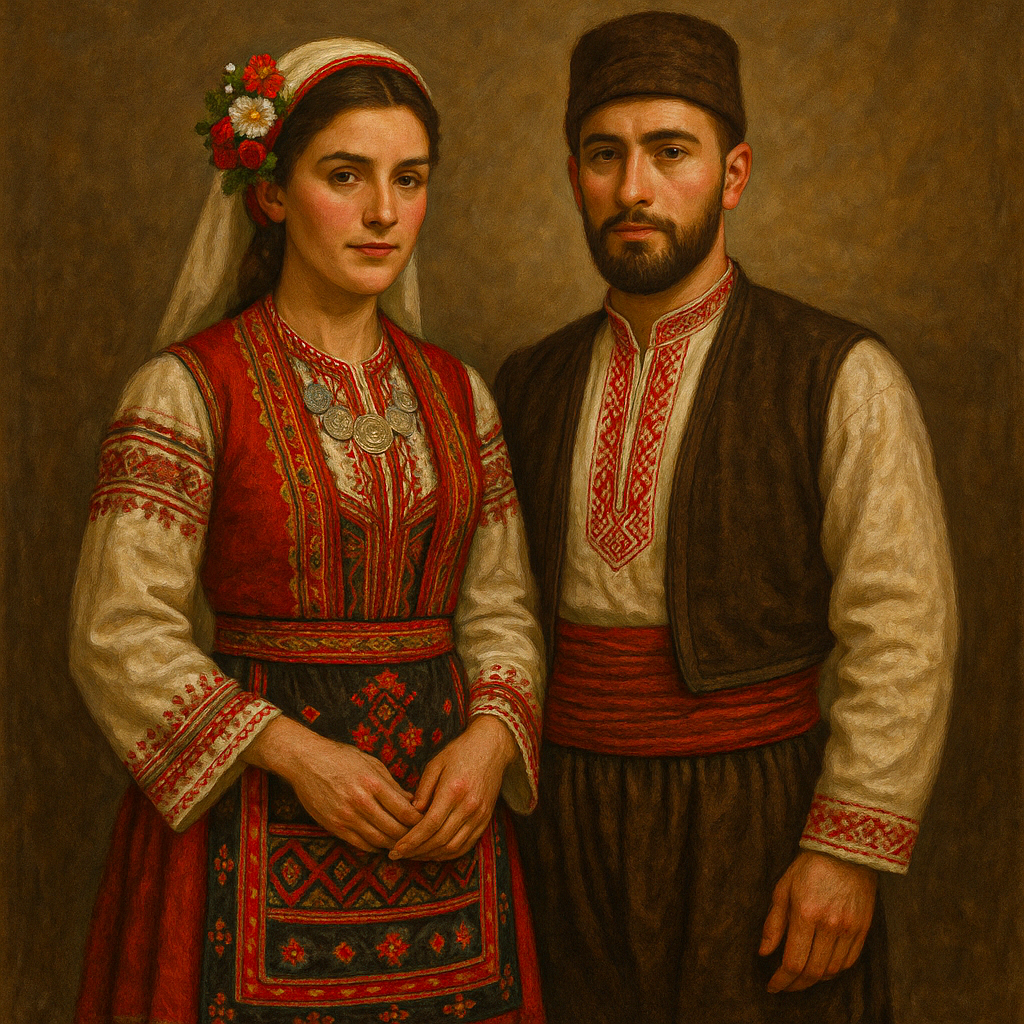
2.3. Macedonian Music
Macedonian Music (music) has a unique sound to it, which is partly due to its unique instrumentation. Typically, a Macedonian band will consist of a large drum called a tupan, a special kind of bagpipe called a gajda, a strummed lute-like instrument called the tambura (related to the strummed tamburitzas of Croatia and Serbia), the end-blown flue called a kaval, and a loud double-reeded oboe called a zurna.
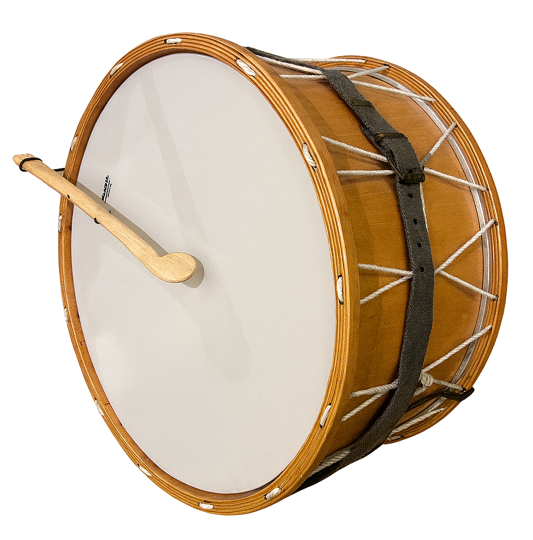
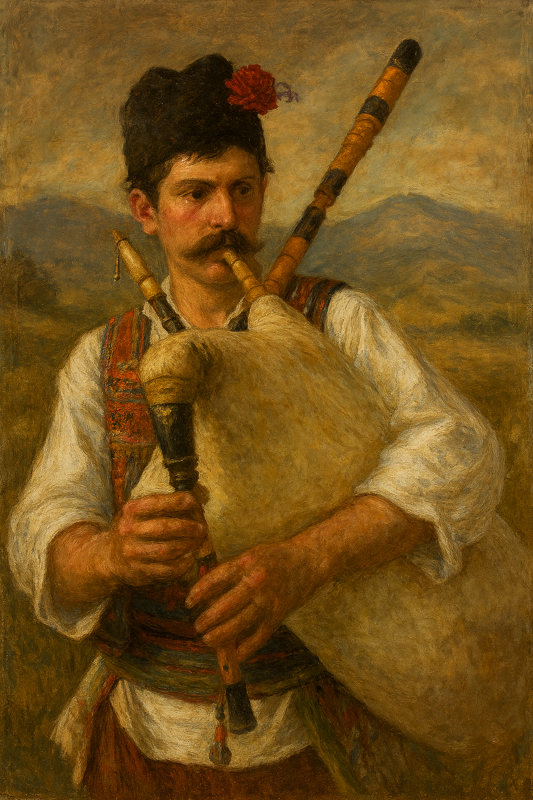
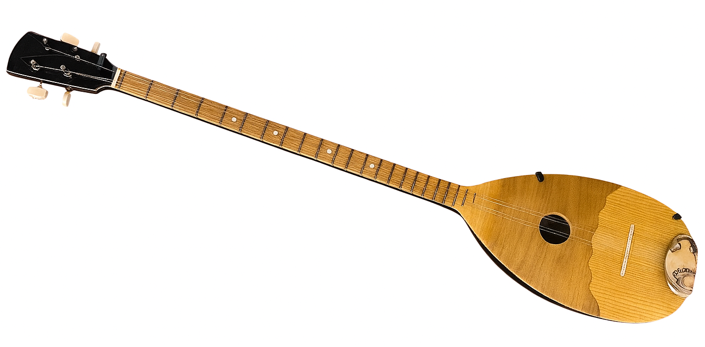
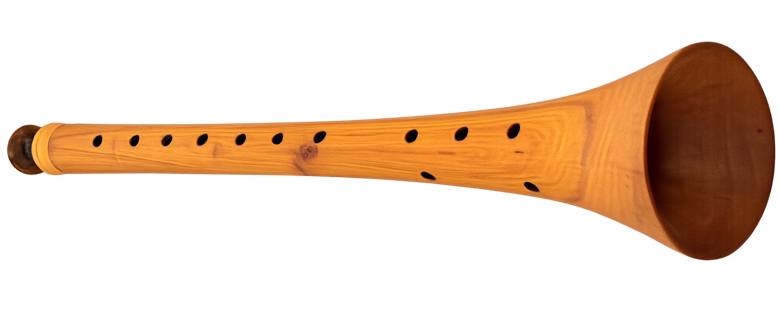
In recent times, the zurna has been replaced by the clarinet and the gajda replaced by the accordion or even synthesizers. Macedonian singing has a very distinctive style, where the vocal quality is deliberately rough.
- Gajda (Pece Atanasovski playing Ovčepolsko: https://youtu.be/OGJxHH2aDUo
- Tambura (Adam Good playing Topansko): https://youtu.be/NWDwGZinUfk
- Zurna and Tupan: https://youtu.be/WEZDxHHFbyc
- Kaval and Gajda: https://youtu.be/WmPk1NpqODQ
- Clarinet: Zoran Dzorlev: https://youtu.be/VyzHgG7Uioc
- Typical Macedonian Singing (Adam Good): https://youtu.be/jxx-qePRPwo
- Electronic Zurla Čoček: https://youtu.be/aRtF_oBXCUI
- Biser (Accordion band playing Pušteno Oro): https://youtu.be/-UEbRvDq2LM
- Teškoto: https://youtu.be/_mN5Id4aeKE
- Pajduško: https://youtu.be/–fApRx5Te0
- Kupurlika: https://youtu.be/Dm6lH5wh94Q (done by Macedonians living in Turkey)
- Zaiko (Greek Macedonia): https://youtu.be/r4t0j02ji4M
Macedonian dances are often in complex meters. While there are a few simple dances in 2/4, 3/4 and 4/4 rhythms, many Macedonian dances are in 7/8 time, which is counted for the dancers as one slow beat consisting of 3 minor beats and 2 quick beats consisting of two minor beats each. So, a typical Macedonian 7/8 is really counted as Slow Quick Quick (SQQ) or (123)(45)(67). This rhythm is typical of the dances Širto and Lesnoto. The opposite counting is also possible, giving QQS (12)(34)(567). This is typically (typical) of the dance call Cigančica. Here are some of the complex meters of Macedonia. There are other complex meters that I have not listed. Many of these complex meters are also found in Bulgaria. You can read all about the different meters found in these countries in chapter 28.
2.4. Macedonian Dance
Macedonian dances are typically open circle or line dances called Oro (The term Oro is related to the Serbian word Kolo, the Bulgarian Horo and the Greek Choros). It is very rare to find a Macedonian couple dance. Like most dances from areas that practice the Eastern Orthodox religion, the lines progress in a counterclockwise direction. There is usually a leader on the right end of the line from whom the rest of the dancers take their cue as to when to start the dance. There are three common positions in which Macedonian dancers hold hands with their neighbors. For slow dances, the hands are most typically in a “W position”, where the arms are bent at the elbow the right hand is positioned fingers up and the left-hand rests fingers down. Dances done primarily by men are in the second handhold, the shoulder hold, where the dancers rest their hands on their neighbor’s shoulders. This hand hold is more common in Aegean Macedonia. Finally, in fast dances or dances with numerous directional changes, the most common hold is the “V position”, where the hands are held with neighbors down by the sides of the body.
Following common practice in countries formerly ruled by the Islamic Ottoman Empire, the dances are often – but not always – segregated by gender. The men dance in one line and the women in another. Often the styling in the dance is quite different between the two genders. Men do large lifts of their knees and exaggerated kicks and leaps. Women on the other hand do much more petite low-to-the-ground steps. It is thought that some of the women’s low and subtle styling is due to the heavy skirts that they wear which limit their movement.
Another important stylistic feature is the very interesting syncopation that Macedonian dancers do in relation to the music. Dancers from western countries are used to taking each step directly on the beat. Macedonian dance often involves what’s known as Zadrška or “holding” (Spasovski p.c. January 23, 2020). They hesitate slightly before stepping. So, the step comes at the end of each beat, or even slightly after. To western eyes, it almost looks like the dancers are dancing off time, but in fact they are completely in sync with the music, they are just shifted slightly in where the footwork occurs relative to the beat.
- Lesnoto: (7/8 counted as SQQ): https://youtu.be/UEd2KUitTgY
- Elerinka (18/8 time counted as QQSQQSQQ) : https://youtu.be/u-Vx9UxDl7Q
- Jove Male Mome (18/8 counted as SQQQQSQQ) Time: https://youtu.be/TrnZQhJ6rpk
- Sandansko (22/8 time counted as QQQSQQQSQQ): https://youtu.be/z12qLwpZko0
- Pušteno: (12/I time counted as SQQSQ): https://youtu.be/vbvNyE4micI
- Dolgoto: (12/8 time counted as QQSQS): https://youtu.be/h-mvmZMhSQ8
- Petrunino (7/8 counted as SQQQS): https://youtu.be/ESGWuxnDbXs
3. Bulgaria
3.1. A Little History
Bulgaria lies in far eastern Europe on the west of the Black Sea. It is bordered by Romania, Serbia, North Macedonia, Greece, and Turkey. The Bulgarians for the most part speak Bulgarian, a Slavic language of the Balkan Branch, although there are significant minorities that speak Vlach (a variety of Romanian), Macedonian, Romani and Turkish.
Bulgaria[3], like many of its neighbors, was once part of the Ottoman Empire and so its music, dance, and clothing bear significant influences of the Turks. After the fall of the Ottomans, Bulgaria was briefly a monarchy, which was allied with Germany in both world wars. After World War II, Bulgaria became part of the Warsaw pact and was a communist dictatorship. As in many Eastern European communist countries, the communist dictatorship collapsed in the late 1980s and early 90s. Amazingly, the heir to the throne of Bulgaria was among the group of the first democratically elected presidents of the country. Today, Bulgaria is among the most stable of the former Eastern European communist satellite countries, and the only one that has never descended into civil or ethnic war. Although there are clear regional differences in culture, the country appears to be relatively united by a notion of “Bulgarianness”.
3.2. Bulgarian Music
Bulgarians use many of the same instruments as their neighbors. The accordion and the clarinet have become increasingly important in Bulgarian folk music, but many traditional instruments are still used. The Kaval (flute), Gadulka (a fiddle-like instrument), Tambura (like the Tamburitzas, Lutes and Bouzoukis of their neighbors), and the large Kaba Gajda are all used.
Bulgarian singing is also very important. The Mystere des Voix Bulgares choir was an international sensation back in mid 1980s. You will never forget traditional a capella Bulgarian close harmony singing once you hear it. The Washington Post (April 29, 1990) described it as:
“The sound is hauntingly beautiful. Mysteriously soothing… Their music is hundreds of years old, with dense, medieval-sounding harmonies sung in a resonant, almost nasal tone.”

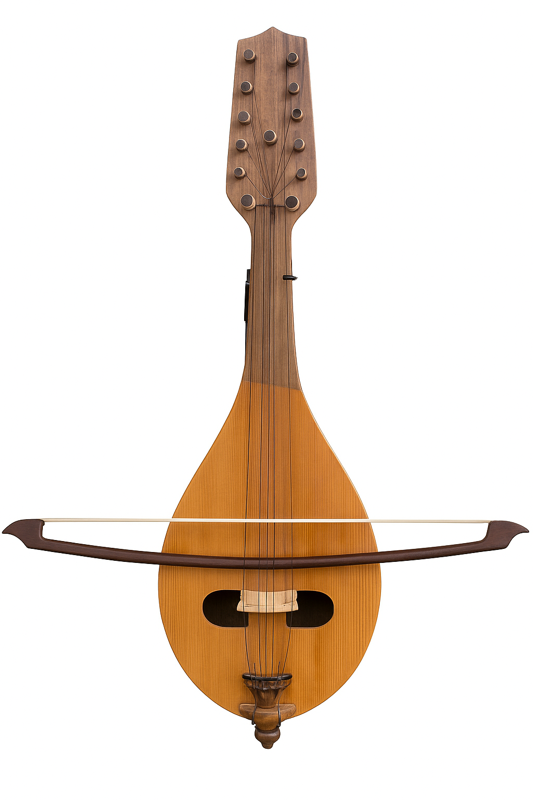

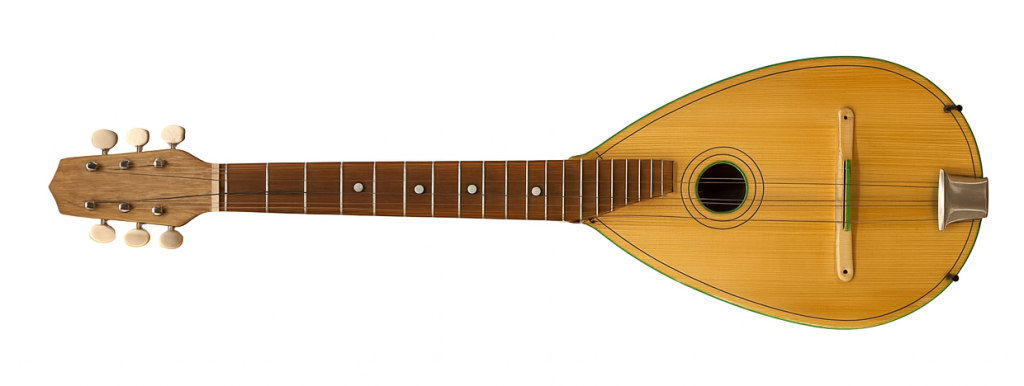
- Bulgarian Accordion: https://youtu.be/94s0_GyJyMM
- Tambura: https://youtu.be/jlCzHGoIhcQ
- Gadulka and Kaval: https://youtu.be/h4rbYIOjP9o
- Bulgarian vocals (beatbox) and Gadulka: https://youtu.be/YqyVP5bN7hw
- Le Mystère de Voix Bulgares (a full concert, listen to at least the first song): https://youtu.be/AFgzzWT3zX4
- Kaba Gajda: https://youtu.be/uioRZd7Et7U
3.3. Bulgarian Traditional Dress
Bulgarian women’s costumes as a whole (there are many regional variations) consist of a white chemise with a black overskirt. The women cover their hair. One normally associates plaids with Scotland; but the women of Bulgaria often wear long plaid skirts or aprons. Men often wear long white or black jackets and wide, colorfully woven belts. One particularly characteristic part of the men’s costume is the men’s tall woolen black hat.
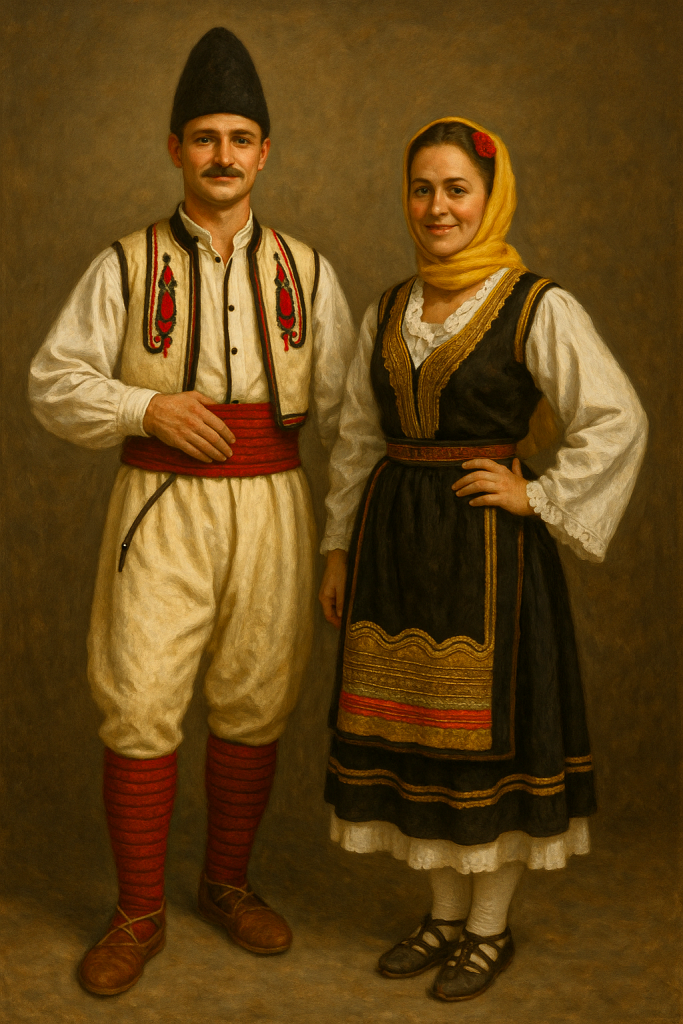
3.4. Bulgarian Ethnographic Regions
In terms of music and folk dance, Bulgaria can be divided up into several ethnographic regions, with clear stylistic differences in terms of music and dance. In the section on Macedonia, we already mentioned the Macedonian styles of Pirin. They commonly do many of the dances we already looked at for Macedonia, such as the Lesnoto (7/8). But they also include complicated rhythmic dances like Jove Male Mome and Elerinka both in (18/8) and other Krivo or complicated meters.
The people of the Šop region (pronounced “Shope” with a long “o”) do many dances that are similar to the dances of their Serbian neighbors. Characteristic of this region are the Račenicas and Šopsko Horos (7/8 time), Gankinos (11/8 time), Dajčovos and Devetorkas (9/8 time). One interesting characteristic of many dances from this region (and other parts of Southern Bulgaria) is the “belt hold” where dancer’s hold onto the belts of their neighbors.
Trakija or Thrace stretches from central Bulgaria all the way over to the border with Turkey and south to Greece. Dances from the region include several Krivo dances and the iconic Trakijska Râčenica, which is a fun and fast-moving dance.
The Rhodopes Mountains are an isolated place, so they have developed their own style of music which relies heavily on the Kaba Gajda. The primary dance of this region (also done in Thrace) is the Pravo Horo. Pravo means “straight” or “even”, and it refers to the fact that the dance is done in an even 2/4 or 6/8 meter rather than one of the Krivo meters of their neighbors.
In the Northwest (Severnjaško), the dances are light, springy and fast. The dances are similar to the dances of the Oltenia and Muntenia regions of Romania that lie just to the north. This region also has a lot of people of Vlach (Romanian-speaking) people. Characteristic dances include Vlaško Horo and Sitno Severnjaško.
In the Dobrudža region the dances like the Tropanka, Râka, and Buenek all involve very Romanian-like stamps and arm swings. These dances are almost always in simple (non-Krivo meters), but the heavy movements, stamping, and arm swinging mark them as very different from other Bulgarian dances.
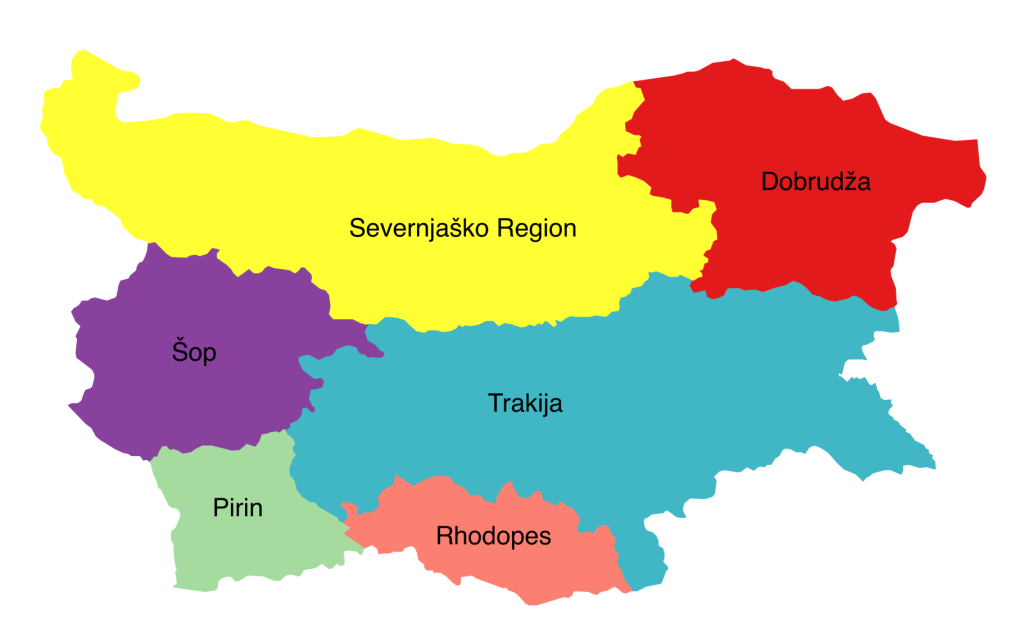
- Dajčovo Horo (9/8 counted as QQQS): https://youtu.be/VYn00g6dh60
- Devetorka (9/8) counted as SSSQS): https://youtu.be/zIljQnR3uqE
- Gankino Horo (11/8 counted as QQSQQ): https://youtu.be/WRdifDUq2EA
- Râčenica (7/8 counted as QQS): https://youtu.be/YTCKw9vxFO8
- Šopsko Horo (2/4 counted as QQS, Shows belt hold): https://youtu.be/ysLF7Ij-QiY
- Krivo Sadovsko Horo (13/8 time QQQSQQ): https://youtu.be/TxGoO7wZHr0
- Četvorno Horo (7/8 counted as SQQ): https://youtu.be/IolB6LVhJFE
- Trite Pâti (2/4 counted as QQQQ): https://youtu.be/4vz3Dyv2kmQ
- Trakijska Râčenica (7/8 counted as QQS): https://youtu.be/YTCKw9vxFO8
- Pravo Horo (2/4 or 6/8 counted as QQSS): https://youtu.be/Wpncg8mHNCU
- Pravo Rhodopsko done to Bulgarian Choral Singing: https://youtu.be/XpGIc7oW0Zs
- Râka (2/4 counted as QQQQ): https://youtu.be/2Bwte5VeZRI
- Tropanka (2/4 counted as QQQQ): https://youtu.be/jbsvmFEHU94
- Another Tropanka (2/4 counted as QQQQ): https://youtu.be/vRH8Z-ejxKA
3.5. Some Unique Traditions in Bulgarian Folk Dancing
3.5.1. Kukeri
At Lent and New Year’s, many men dress in elaborate and scary costumes, covering themselves in animal skins and wearing huge hats. They also often carry and wear bells. They walk through town, stopping to perform ritual dances that are supposed to scare away evil spirits. These dancers are known as Kukeri. It’s thought that the Kukeri tradition descends from the Cult of Dionysus in ancient Greece, and that maybe the costumes are meant to make the men resemble goats, sheep, or bears, which were symbolic of fertility and fecundity,[4] the tall hats perhaps being phallic in nature, although that’s only speculation.
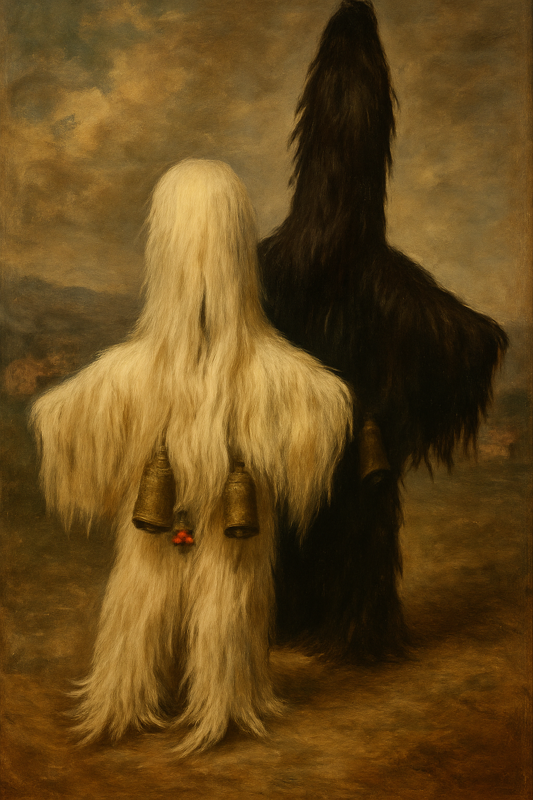
- Kukeri Dancers: https://youtu.be/SWIK0SfT4Mw
- A visually stunning video on the Kukeri: https://youtu.be/LsmAUHeuWOE
3.5.2. Lazaruvane (Lazarki)
While the Kukeri are mainly men, there is a parallel tradition for women at Lent, called Lazaruvane. The Lazarki dancers are all girls, usually all under the age of 16. Participating in the Lazaruvane ceremony is required for the girl to get married later in life. The girls wear flower wreaths on their heads and walk around the village from house to house singing and dancing. If your house is visited by the Lazarki, it is considered a blessing for the year and good luck. Householders give the Lazarki gifts. At the end of the ceremony the girls go to the river and drop their wreaths in as a ritualistic offering.
- Lazarki dance: https://youtu.be/mQisuw6i-jY
- The Lazarki ritual: https://youtu.be/UZg1J_lYJ8A
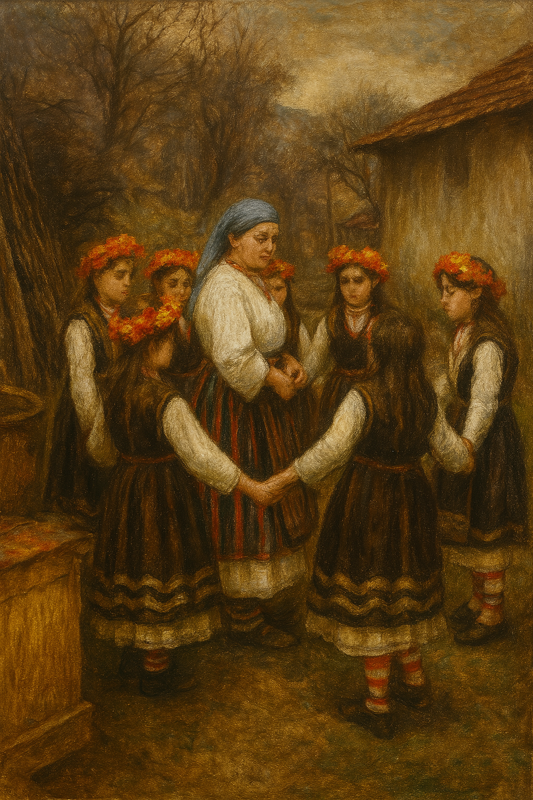
3.5.3. Modern Bulgarian Club Dancing (Horoteka)
In the past 15 years, a new tradition called Horoteka has emerged in Bulgaria the emergence of Modern Bulgarian Folk Dance clubs. These clubs meet and practice traditional dances, but the dances are often done to modern recordings of traditional music. These modern recordings can even include electronic elements and rap! The Club Dancers have their own unique costumes. They wear black pants or yoga pants; everyone wearslong T-shirts that sport printed-on designs derived from traditional embroidery (ševitsa); and they tie loose cloth belts around the T-shirts. Each club has their own T-shirt design. The women often wear a large red or white flower behind their ears. The dancers compete at folk dance festivals, where each club is evaluated on how well they perform the dances and how in sync they are.
- Modern Club Dancing: Циганско Хоро: https://youtu.be/SRscDLjwsQY
- Modern Club Dancing: Малешевско Хоро: https://youtu.be/-4-tnLHk48w
- Modern Club Dancing: Чичово Хоро: https://youtu.be/LWMy8gCrYsk

Further Reading
- Atanasovki (2002), Bates (1994), Bilides, MacFarlane, and Stately (1997), Caron and Spinks (1983), De Jong (1995), Forsyth (1996), Friedberg (2004), Friedberg (2005), Geisler (1989c), Hunt (1996), Ivanova (2005), Katsarova (1948), Katzarova-Kukudova and Djenev (1958), King (2018), Moreau (n.d), Rice (1994), Spasovski (2007). See the references at the end of this book for full citations.
Some Suggested Dances for Teaching
Bulgaria
- Vrapčeto: http://folkdancemusings.blogspot.com/2014/08/vrapceto-bulgaria.html
- Andrew’s Little Račenica: http://folkdancemusings.blogspot.com/2017/10/andrews-little-racenica-bulgaria.html
- Cigansko Horo: http://folkdancemusings.blogspot.com/2014/03/cigansko-horo-cicovata-bulgaria.html
- Čukanoto: https://folkdancemusings.blogspot.com/2019/07/cukanoto-yves-moreau-version-bulgaria.html
- Dobra Nevesto: http://folkdancemusings.blogspot.com/2014/07/dobra-nevesto-pirin-macedonia.html
- Goce Berberot: http://folkdancemusings.blogspot.com/2017/10/goce-berberot-tucson-version-macedonia.html
- Jambolska Râčenica: http://folkdancemusings.blogspot.com/2008/03/jambolska-renica-bulgaria.html
- Nevesto Crven Trendafil: http://folkdancemusings.blogspot.com/2014/03/nevesto-carven-trendafil.html
- Tropanka Iz Dobrudža: http://folkdancemusings.blogspot.com/2015/10/tropanka-iz-dobrudza-bulgaria.html
Macedonia
- Arap: http://folkdancemusings.blogspot.com/2014/01/arap-macedonia.html
- Bufčansko: http://folkdancemusings.blogspot.com/2014/04/bufcansko-macedonia.html
- Dimna Juda: http://folkdancemusings.blogspot.com/2008/04/dimna-juda-macedonia.html
- Ivanice: http://folkdancemusings.blogspot.com/2014/04/ivaniceivanica-macedonia.html
- Pirinska Četvorka: http://folkdancemusings.blogspot.com/2014/08/pirinska-cetvorka-macedonia.html
- Krivo Žensko: http://folkdancemusings.blogspot.com/2016/05/krivo-zensko-oro-macedonia.html
- Lesnoto: http://folkdancemusings.blogspot.com/2014/03/lesnoto-macedonia.html
Media Attributions
- Figure 13.1: Map of Macedonia and Bulgaria © John W. W. Powell, used with permission. Additional citations geospatial data in map.
- Figure 13.2: Map of the three regions of traditional Macedonia and the modern countries that they are in © Andrew Carnie, created with Mapchart.net
- Figure 13.3: Macedonian Folk Costumes © Saman Meihami, assisted by ChatGPT. Used with permission.
- Figure 13.4: A Tupan © Musical Instrument Museum, Phoenix. background removed by ChatGPT. Used with permission
- Figure 13.5: A man playing the gajda. © Andrew Carnie with the assistance of ChatGPT
- Figure 13.6: A tambura © Musical Instrument Museum, Phoenix. Used with permission.
- Figure 13.7: Zurna © Musical Instrument Museum, Phoenix. Cleaned up using ChatGPT. Used with permission
- Figure 13.8: Kaval © Andrew Carnie, personal collection
- Figure 13.9: Gadulka © Musical Instrument Museum, Phoenix. Cleaned up with ChatGPT. Used with permission.
- Figure 13.10: Kaba Gajda © Musical Instrument Museum, Phoenix. Used with permission
- Figure 13.11: Tambura © Musical Instrument Museum, Phoenix. Used with permission
- Figure 13.12: Bulgarian Folk Costumes © Saman Meihami, assisted by ChatGPT. Used with permission
- Figure 13.13: The rough oulines of the major ethnographic regions of Bulgaria © Andrew Carnie, using Mapchart.net
- Figure 13.14: Kukeri costume © Andrew Carnie with ChatGPT assistance, based on a costume at the Musical Instrument Museum, Phoenix
- Figure 13.15: Lazarki dancers © Andrew Carnie with the assistance of ChatGPT based on https://en.wikipedia.org/wiki/Lazarice#/media/File:Lazaruvane_Bov.JPG is licensed under a Public Domain license
- Figure 13.16: Horoteka Club Dancing T-shirt © Andrew Carnie, personal collection. T-shirt designed by Iliana Bozhanova
- See the Wikipedia article at https://en.wikipedia.org/wiki/Macedonia_(region) and the references cited therein. ↵
- https://www.nytimes.com/2019/01/20/world/europe/greece-macedonia-protest.html ↵
- https://en.wikipedia.org/wiki/History_of_Bulgaria ↵
- https://en.wikipedia.org/wiki/Kukeri ↵

